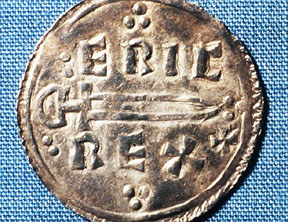 Live
Issues in Saga-Forschung II
Live
Issues in Saga-Forschung II
 Live
Issues in Saga-Forschung II
Live
Issues in Saga-Forschung II
LIVE ISSUES IN SAGA-FORSCHUNG II
2d posting on "Live Issues in Saga-Forschung."
7. Verse: A. Wolf, "Zur Rolle der visur in der altnord. Prosa," Fs.
L. C. Franz (Innsbruck, 1965), 459-484; Bjarni Einarsson,
Skaldasoegur: um uppruna og edli astaskaldasagnanna fornu
(Reykjavik, 1961); A. Hruby, Wann sprechen die Personen der
islaendischen Saga eine Strophe? (Vienna, 1932); Einnur Jonsson,
"Sagaernes lausavisur," Aarbo/ger (1912), 1-57.
8. Language: Steblin-Kamenskij, 25 ff.; Paul Schach, "The Use of
the Simile in the Old Icelandic Family Sagas," SS 24 (1952), 149-
165; L. M. Hollander, "Litotes in Old Norse," PMLA 53 (1938), 1-33;
Maria Mueller, Verhuellende Metaphorik in der Saga (1939); Marchand
handout, "The Use of Etymology in the Postola Soegur."
9. Dating. The problem is the distinction between the time of the
narrative (erzaehlte Zeit), the time of the narration
(Erzaehlzeit), and the time of attestation (the manuscript
evidence), which people seem to get confused. E. O. Sveinsson,
Dating the Icelandic Sagas: An Essay in Method (London, 1958), is
the standard work; see also a later reworking: Ritunartimi
Islendingasagna (Reykjavik, 1965).
10. Courtly Romance: P. V. Rubow, "De islandske sagner," Tilskueren
(1928), 347-57, 2, 170-174, reprinted in his Smaa kritiske Breve
(Copenhagen, 1936), 7-33 (English translation, "The Sagas," in Two
Essays, 1947), first proposed that the courtly romance, as
practiced at the court of Haakon, was the source of saga writing.
Carney supports the influence of the Tristan in his book Studies in
Irish Literature and History (1955).
11. Motifs. There is an excellent Motif-Index of Early Icelandic
Literature, by Inger M. Boberg (Bibl. Arnamagnaeana 27; Copenhagen,
1966), keyed to the system of the Stith Thompson Motif Index of
Folk Literature. This permits cross-referencing to Cross's Motif
Index of Early Irish Literature, for example, though this has not
been done systematically.
12. Structural Analysis. G. Hellwig, Die Struktur der Hallfredar
Saga (Munich, 1967); M. C. van Toorn, "Zur Struktur der Saga," ANF
73 (1958), 140-168; H. M. Heinrichs, "Die kuenstlerische Gestaltung
des Thorsteins thattr stangarho"ggs," Festschrift W. Baetke
(Weimar, 1966), 166-174; A. C. Bouman, Patterns in Old English and
Old Icelandic Literature (Leiden, 1962); T. M. Anderson, The
Icelandic Family Saga: An Analytic Reading (Cambridge, 1967),
represents a sort of attempt at a Proppian analysis, but sloppily.
13. Romans a clef. There are those who maintain that the sagas
were really Schluesselromane, with veiled references to people
living at the time of the composition of the saga, a theory
proposed for Mother Goose Rhymes, for example; cf. Barni
Gudhmundsson, Ho"fundar Njalu (Reykjavik, 1958).
14. Attribution: Most of the sagas have been attributed to some
Icelander at some time during their studdy. For a study of
attribution, see Wayne B. Kraft's dissertation. M. E. Steblin-
Kamenskij, "An Attempt at a Semantic Approach to the Problem of
Authorship in OIcel. Literature," ANF 81 (1966), 24-34. Statistical
methods according to the Swedish school have been used by P.
Hallberg, Stilsignalelement och foerfatterskap i norroen
sagalitteratur (Goeteborg, 1968); see his "Om spraakliga
foerfattarkriterier i islaendska sagatexter," ANF 80 (1965), 157-
186).
15. Style: Still the best introduction in English: Otto Springer,
"The Style of the Icelandic Family Sagas," JEGP 38 (1939), 107=128.
16. Hagiographic Influence: Turville-Petre, 142: "The learned
literature did not teach the Icelanders what to think or what to
say, but it taught them how to say it. It is unlikely that the
sagas of kings and of Icelanders, or even the sagas of ancient
heroes, would have developed as they did unless several generations
of Icelanders had first been trained in hagiographic narrative."
Lucy G. Collings, "The Codex Scardensis: Studies in Icelandic
Hagiography" (Cornell U. Dissertation, 1969); Lars Loennroth,
European Sources of Icelandic Saga-Writing (Stockholm, 1965); Ole
Widding, Hans Bekker-Nielsen, L. K. Shook, "The Lives of the Saints
in Old Norse Prose. A Handlist," MS 25 (1963), 294-337.
17. Of course, there are the usual problems of editing, meanings of
words, dialect, sources, intertextuality, you name it. The above is
just to moisten your appetite (you live among 'em, you got to talk
like 'em).